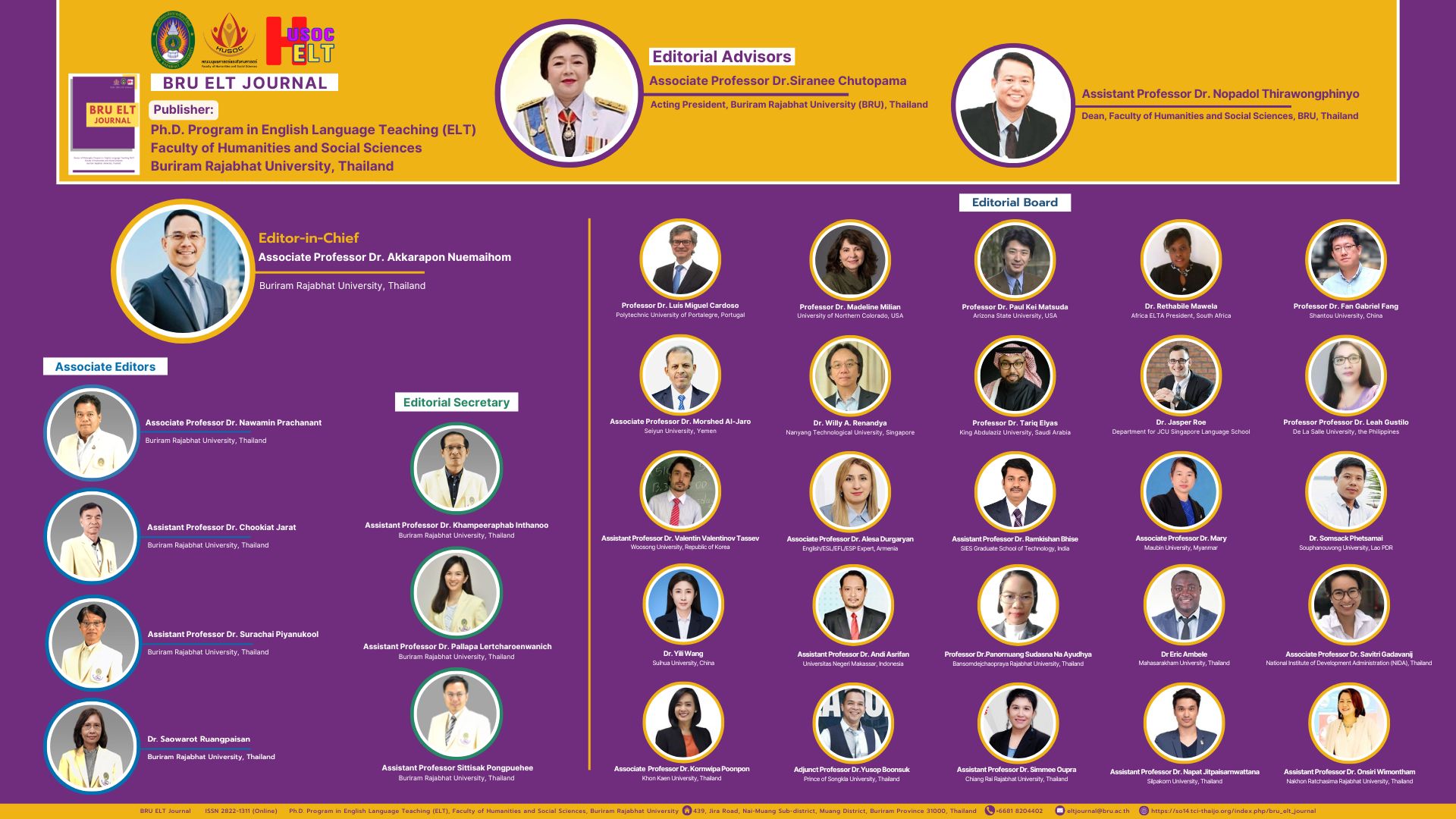The Formulaic Nature of Comics: Language Learning and Multimodal Texts
DOI:
https://doi.org/10.14456/bej.2023.19Keywords:
comics, formulaic language, multiliteracies, second language teachingAbstract
Can comics be described as an excellent ESL/EFL teaching and learning tool? This paper explores the formulaic nature of multiliteracy materials, with a particular focus on comics and similar visual narratives, to describe their potential as language learning/teaching tools. Building on the New London Group’s concept of multiliteracies (1996), it looks at the theoretical foundation for using multiliteracy materials such as comics in the classroom and offers specific examples of how recognizing the formulaic nature of such narratives can support the second/foreign language acquisition and cultural negotiation process. Notably, the paper looks at the formulaic from several perspectives, including the traditional definitions of formulaic language (such as common collocations, idioms, and so forth) and the formulaic structure of visual narratives as designed discourses and texts. The positive impact on learners’ personal linguaculture and intercultural personhood is illuminated in this article.
References
Baddock, B. (1983). Press ahead. Pergamon Press.
Burmark, L. (2002). Visual literacy. Association for Supervision and Curriculum Development.
Cary, S. (2004). Going graphic: Comics at work in the multilingual classroom. Heinemann.
Crystal, D. (1997). English as a global language. Cambridge University Press.
Eisner, W. (2006). Comics and sequential art: Principles and practice of the world’s most popular art form. Poorhouse Press.
Hamston, J. (2006). Pathways to multiliteracies: Student teachers’ critical reflections on a multimodal text. Australian Journal of Language and Literacy, 29(1), 38-51.
Hanauer, D. I. (2010). Poetry as research: Exploring second language poetry writing. John Benjamins.
Hodge, R., & Kress, G. (1988). Social semiotics. Cornell University Press.
Kanno, Y., & Norton, B. (2003). Imagined communities and educational possibilities: Introduction. Journal of Language, Identity, and Education, 2(4), 241-249.
Kim, Y. Y. (2008). Intercultural personhood: Globalization and a way of being. International Journal of Intercultural Relations. 32, 359-368.
Kojima, H., & Togami, S. (2009). Manga guide to calculus. No Starch Press.
Kress, G. (2010). Multimodality: A social semiotic approach to contemporary communication. Routledge.
Kurosawa, S., & Kaneko, Y. (2006, October). Using comic books in EFL classrooms in Japan. Paper presented the Three Rivers TESOL Annual Conference, Pittsburgh, PA.
Lapidus, A. (2008, November). Exploring the pedagogy of multiliteracies in TESOL contexts. Paper presented at the PennTESOL-East 2008 Conference, Philadelphia.
Lapidus, A. (2013). English in a non-place: Supermodernity and ESL pedagogy. Journal of English as an International Language, 8(2), 1-9. http://www.eilj.com/images/pdf/EILJ2013_Nov2013_Vol8No2.pdf
Lapidus, A., Kaveh, Y. M., & Hirano, M. (2013). ESL teachers/ESL students: Looking at autoethnography through the lens of personetics. Second Language Journal, 5(1), 19-42. http://escholarship.org/uc/item/7b733911
Larsen-Freeman, D., & Anderson, M. (2011). Techniques and principles in language teaching (3rd ed.). Oxford University Press.
Lim, Y. (2011). Educational graphic novels: Korean children’s favorite now. Bookbird: A Journal of International Children's Literature, 49(4), 40-48.
Makhlina, S. T. (2010). Lektsii po semiotike kul’tury i lingvistike [Semiotics of culture and linguistics lectures]. SPbKO.
McAllister, M. P., Sewell, E. H., & Gordon, I. (2001) (Eds.). Comics and ideology. Peter Lang Publishing.
McCloud, S. (1993). Understanding comics: The invisible art. Kitchen Sink Press.
McCloud, S. (2000). Reinventing comics: How imagination and technology are revolutionizing an art form? Perennial/HarperCollins.
McCloud, S. (2006). Making comics: Storytelling secrets of comics, manga and graphic novels. HarperCollins.
Norton, B., & Toohey, K. (2004). Introduction. In B. Norton & K. Toohey (Eds.), Critical pedagogies and language learning (pp. 1-17). Cambridge University Press.
Nunan, D. (1988). The learner-centered curriculum. Cambridge University Press.
Pavlenko, A. (2003). I never knew I was bilingual: Reimagining teacher identities in TESOL. Journal of Language, Identity, and Education, 2(4), 251-268.
Risager, K. (2008, March). Towards a transnational paradigm in language and culture pedagogy. Paper presented the AAAL 2008 Annual Conference, Washington, DC.
Samantray, K. (April, 2009). Comics as frames of references: From reading to writing. Paper presented at the IATEFL 2009 conference, Cardiff, UK.
Schodt, F. L. (2005). Japanese manga invades America. In D. M. Haugen (Ed.), Comic books: Examining pop culture (pp. 145-152). Thomson Gale/Greenhaven Press.
Takahashi, S. (2008). Manga guide to statistics. No Starch Press.
The New London Group (1996). A pedagogy of multiliteracies: Designing social futures. Harvard Educational Review, 66(1), 60-92.
Voloshinov, V. N., & Bakhtin, M. M. (2010). Antropolingvistika [Anthropolinguistics]. Labirint.
Vygotsky, L. S. (2008). Pedagogicheskaya psikhologiya [Pedagogical psychology]. AST/Astrel’/Khranitel’.
Wood, D. (2010). Formulaic language and second language speech fluency. Continuum.
Yoon, Y. B., & Kellogg, D. (2002). “Ducks” and “parrots”: Elaboration, duplication and duplicity in a cartoon discourse completion test. Evaluation and Research in Education, 16(4), 218-239.
Yorio, C. (1980). Conventionalized language forms and the development of communicative competence. TESOL Quarterly, 14, 433–442.






